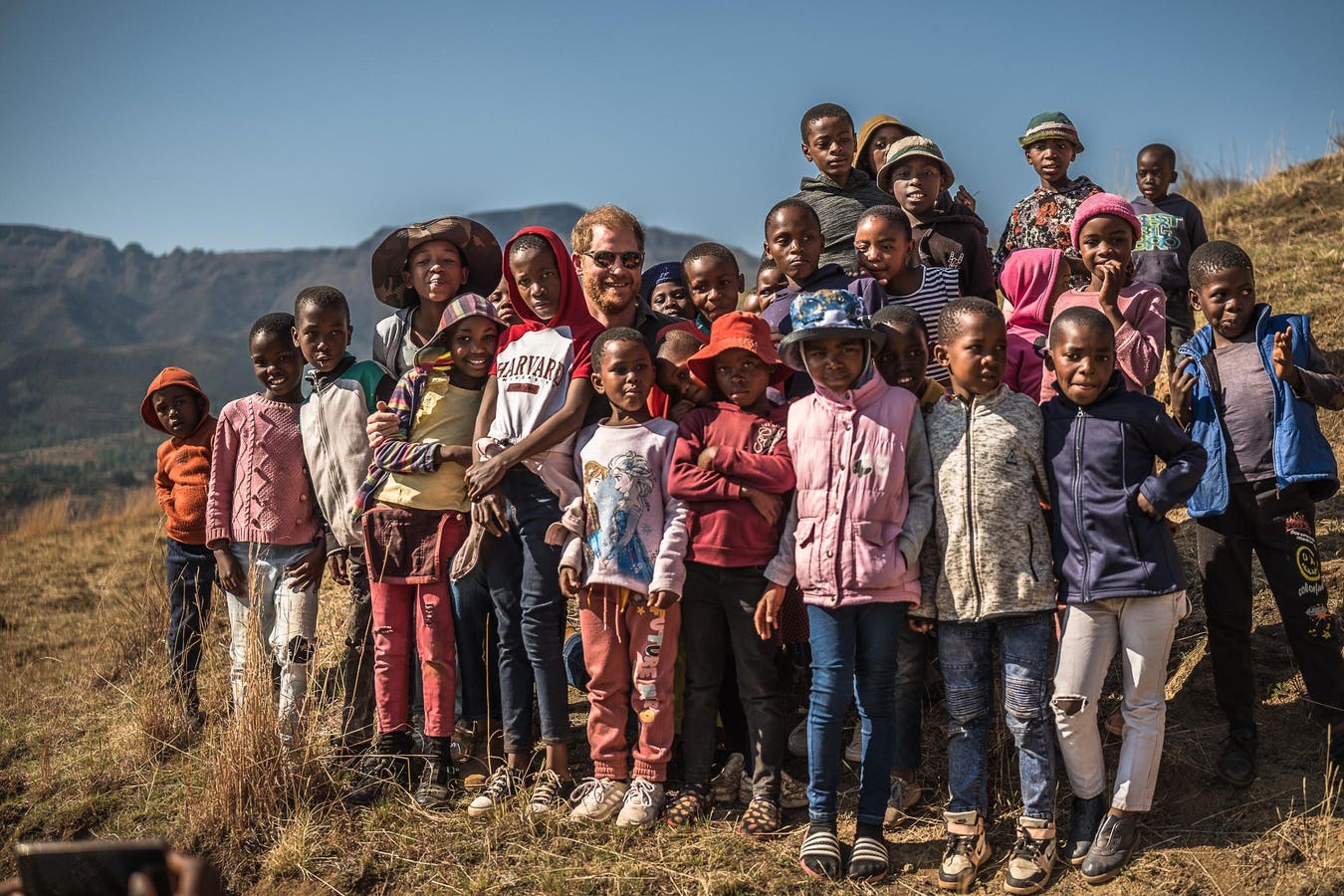MASERU, LESOTHO – OCTOBER 02: Prince Harry, Duke of Sussex poses for a photo with members of the community during a visit to Matlameng – Ha Mahlehle in the Leribe region with Sentebale to meet with the community and see the climate resilience project in action on October 2, 2024 in Leribe, Lesotho. Joining the visit, alongside the Co-Founding Patrons Prince Harry, The Duke of Sussex, and Prince Seeiso of Lesotho, and Board Chair Dr. Sophie Chandauka MBE were a group of innovative international funders and business leaders interested in the Southern African region. (Photo by Brian Otieno/Getty Images for Sentebale )
Getty Images for Sentebale
Trillions of dollars have been pledged for climate action. Yet less than one percent reaches the communities for grassroots adaptation, places where a single flood can destroy crops, or a missed planting window can mean the difference between food security and famine.
These are also the places where small, timely investments, a microloan for climate-smart seeds, a microinsurance payout before a storm, a community savings fund for irrigation, could turn vulnerability into resilience. But the current climate finance system, designed for control and compliance, too often locks these communities out.
Tom Mitchell, executive director of the International Institute for Environment and Development (IIED), has seen this dynamic play out for years. “We’ve effectively designed a system that is impossible to get the resource to where it’s needed most,” he says. “On the side, there’s lots of organizations trying to find other ways to do it… almost despite the international climate system, rather than being directly supported by it.”
The Scale Of Financial Exclusion
Despite record pledges, independent tracking shows less than one-tenth of climate finance explicitly targets local action, and under 3% reaches the world’s least developed countries. The ten nations most affected by climate change over two decades received under 2% of total flows, evidence that the money systematically bypasses those on the frontlines.
Part of the problem is that many vulnerable communities lack access to vital financial services, that could otherwise be a lifeline for withstanding shocks and accessing economic opportunities in the wake of climate events. Sophie Sirtaine, managing director of CGAP, points out that 1.3 billion people still do not have a financial account. “They operate entirely in cash,” she explains. “They can’t receive a transfer from their government or from friends and family, they can’t save securely, they can’t borrow to invest in new technologies to adapt to climate change, and they can’t insure themselves.”
Even among the 75% of the global population considered “financially included,” only a fraction have access to the savings, credit, and insurance products that enable people to withstand shocks. Globally, an estimated four billion adults are uninsured or underinsured, and climate change is making that gap more dangerous every season.
The World Bank’s Global Findex 2025 report highlights how disproportionately the poor are hit: across low- and middle-income countries (LMICs), the poorest 40% were a third more likely to experience a natural disaster than the richest 60%. In low-income countries, more than two-thirds of people affected by extreme weather reported loss of income (69%) or assets (72%). A financing gap of $5.2 trillion annually for micro, small, and medium enterprises in emerging markets highlights how systemic the barriers are.
Why Money Stalls At The Top
The effectiveness of locally led approaches is not in question. Communities managing forests, water, or farmland have decades, sometimes centuries, of experience adapting to shifting conditions. The problem is that climate capital rarely funds them directly. Sirtaine calls this a “fundamental mismatch” between where investment flows and where it is most needed. Climate funds, she says, are not always going to adaptation and resilience in emerging markets and are not sufficiently reaching the hands of the people who could act most effectively with them.
Mitchell adds that climate finance’s fixation on risk mitigation creates a structural barrier. “Blended finance, as it’s currently practiced, simply doesn’t work in the contexts where need is greatest,” he says. “The risk appetite is minimal, and when investors can choose to work in middle-income markets with greater financial certainty, that’s where they go.”
Fixing the problem may require rules that push capital closer to the ground. That means adopting and enforcing the Principles for Locally Led Adaptation across major funders; widening ‘direct access’ and simplifying approvals at major funds like the Green Climate Fund so qualified national entities can draw smaller, faster tranches through simplified approvals; and setting explicit floors for adaptation finance so resilience is not treated as residual
Beyond Finance: The Information Dimension
Resilience is undermined not just by lack of money, but by lack of trusted information. In climate-affected regions, households often hesitate to take up financial tools because they don’t believe they will work. If farmers doubt an insurance payout will ever arrive, or if rumors spread that savings products are unsafe, even well-designed solutions go unused. Misinformation can become another barrier to resilience, reinforcing financial exclusion.
Research on climate insurance bears this out. Experiments with index-based products have consistently found that adoption rates remain low when people are unsure about how payouts work. Where trust and clarity improve, when households see real payouts triggered by weather data, demand rises significantly.
Inclusive finance institutions already work to close this gap. Loan officers, cooperatives, and microfinance groups don’t just disburse credit or insurance; they explain how these tools function, when payouts trigger, and how families can prepare for shocks. That role as trusted intermediaries is critical, especially in communities where mistrust of government and banks runs deep.
At the same time, the broader information environment matters. Disinformation campaigns, what some call engineered confusion deliberately erode trust in climate solutions and stall action. Big Tech platforms, now the main pipelines for weather data, forecasts, and climate narratives, can amplify these distorted messages. As recent reports of Google’s fossil fuel ties illustrates, even companies that brand themselves as climate leaders have at times enabled narratives that undermine resilience.
This disconnect highlights a dangerous paradox: the same platforms that communities, governments, and businesses depend on for data and forecasts can also amplify the very misinformation that causes households to reject financial tools designed to protect them.
Finance and information, in other words, are twin pillars of resilience. One equips communities with the means to act, the other with the confidence to act wisely. Without both, the promise of inclusive finance may well remain constrained.
A Systemic Failure That Needs Redesign
The lesson is stark – climate finance is failing not because resources are lacking, but because systems are misaligned. Risk perceptions keep capital in safe markets, compliance-heavy rules choke local access, and misinformation corrodes trust in the very tools meant to help.
For business leaders, this is more than a development failure, it’s market failure. Global catastrophe losses exceeded $320 billion in 2024, with insured losses topping $100 billion for the fifth consecutive year, a widening protection gap that feeds volatility . By contrast, the economics of adaptation are favorable: every dollar invested in resilience can return up to ten in avoided losses and productivity gains . Capital stuck at the top is not just a lost impact, it’s stranded capital.
The challenge now is to shift focus from pledges at the top to delivery at the ground level. The institutions that already serve low-income households and small enterprises, from microfinance groups to cooperatives and inclusive fintechs, show what is possible. The real test is whether global finance is willing to trust and scale these proven systems, turning climate commitments into resilience that lasts.









